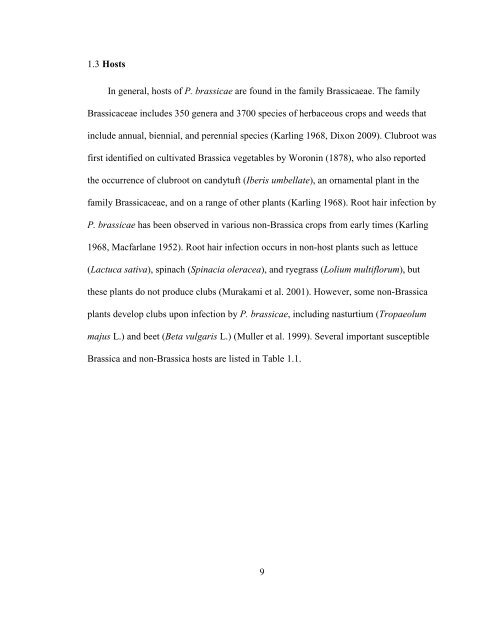- Page 1 and 2: Influence of pH, Temperature, and B
- Page 3 and 4: and Lee). The mean clubroot inciden
- Page 5 and 6: TABLE OF CONTENTSACKNOWLEDGEMENTS .
- Page 7: 6 APPENDIX: 2 SUPPLEMENTARY TABLES
- Page 10 and 11: LIST OF ACRONYMSANOVABDCIAnalysis o
- Page 12 and 13: pathogen in the Holland Marsh area
- Page 14 and 15: 1.2.1 PathotypesHonig (1931) was th
- Page 16: were distinguished using only three
- Page 21 and 22: erucic acid and 30 µmoles glucosin
- Page 23 and 24: Table 1.2. Economically important B
- Page 25 and 26: July and August. The temperature du
- Page 27 and 28: (Colhoun 1953). Studies on differen
- Page 29 and 30: Soil compaction, which has been ass
- Page 31 and 32: calcium source resulted in a small
- Page 33 and 34: effective against P. brassicae has
- Page 35 and 36: are filamentous rod-shaped gram-pos
- Page 37 and 38: another study, the biofungicides Se
- Page 39 and 40: Oomycetes and plasmodiophorids at v
- Page 41 and 42: has been no systematic study of the
- Page 43 and 44: 2 CHAPTER 2INFLUENCE OF pH AND TEMP
- Page 45 and 46: The optimum temperatures for clubro
- Page 47 and 48: When the cotyledons were fully expa
- Page 49 and 50: the plants were watered with deioni
- Page 51 and 52: dehisced sporangia looked like empt
- Page 53 and 54: epetition. There was no repetition
- Page 55 and 56: RHI = -169.14 + 27.54 (temp°) - 0.
- Page 57 and 58: on canola seedlings at 12 days afte
- Page 59 and 60: The individual regression analysis
- Page 61 and 62: Multiple regression equations were
- Page 63 and 64: hair infection was strongly and pos
- Page 65 and 66: (Macfarlane and Last 1959, Myers an
- Page 67 and 68:
temperature (Adhikari, 2010, Gossen
- Page 69 and 70:
3.2 IntroductionClubroot of crucife
- Page 71 and 72:
organic soil, whereas only 25% wate
- Page 73 and 74:
(1.34% Bacillus subtilis QST 713),
- Page 75 and 76:
2. To assess the interaction of pat
- Page 77 and 78:
and the spray width was approximate
- Page 79 and 80:
3.3.2 Field trials - Napa cabbageTw
- Page 81 and 82:
Four types of growth media were ass
- Page 83 and 84:
treatments (described in detail in
- Page 85 and 86:
Field capacity (%) =(Initial weight
- Page 87 and 88:
3.4 Data analysisThe data were anal
- Page 89 and 90:
Analysis of variance was conducted
- Page 91 and 92:
etween clubroot severity and cumula
- Page 93 and 94:
growth medium) for severity, but no
- Page 95 and 96:
B) Saturated canola - Clubroot inci
- Page 97 and 98:
10080A) Drained trialab ab bcaabPos
- Page 99 and 100:
3.6.2 Experiment 2 - Shanghai pak c
- Page 101 and 102:
Table 3.5 Analysis of variance for
- Page 103 and 104:
A three-way interaction (biofungici
- Page 105 and 106:
correlated with micro-pore volume.
- Page 107 and 108:
negative correlation between clubro
- Page 109 and 110:
that a greater number of assessment
- Page 111 and 112:
supports the observations of previo
- Page 113 and 114:
In Experiment 3, both Prestop and S
- Page 115 and 116:
depending on factors such as soil m
- Page 117 and 118:
growth room trials, up to 6 x 10 9
- Page 119 and 120:
Biofungicides have been included as
- Page 121 and 122:
esults indicate that application of
- Page 123 and 124:
growth in rhizopshere zone (Mikkels
- Page 125 and 126:
iofungicides varies with the growth
- Page 127 and 128:
Bremer, H., B. Wehnelt, and E. Bran
- Page 129 and 130:
Dobson, R., R. L. Gabrielson, and A
- Page 131 and 132:
Hwang, S. F., S. E. Strelkov, B. D.
- Page 133 and 134:
Mitani, S., K. Sugimoto, H. Hayashi
- Page 135 and 136:
PMRA 2008. Registration Decision fo
- Page 137 and 138:
Tommerup, I. C., and D. S. Ingram.
- Page 139 and 140:
5 APPENDIX 1: ANOVA TABLES FOR CHAP
- Page 141 and 142:
Clubroot severity: Multiple regress
- Page 143 and 144:
7 APPENDIX 3: ANOVA TABLES FOR CHAP
- Page 145 and 146:
2011 - Root weight of 10 plantsSour
- Page 147 and 148:
Runs 1 and 2 combined DSIRandom eff
- Page 149 and 150:
Table. A3.9 Interaction of biofungi
- Page 151 and 152:
9 APPENDIX: 5 RAW DATA FOR CHAPTER
- Page 153 and 154:
CI- Clubroot incidence (%); - Not d
- Page 155 and 156:
25 7.0 3 43.66 4.33 15.89 20.33 56.
- Page 157 and 158:
10 APPENDIX 6 RAW DATA FOR CHAPTER
- Page 159 and 160:
Raw data for growth room trials Exp
- Page 161 and 162:
Soilless P6 Prestop 1 6.67 10.00 24
- Page 163 and 164:
Sand P3 Prestop 1 86.11 100.00 80.0
- Page 165 and 166:
Mineral T5 - 1 80.00 50.00 70.00 43
















